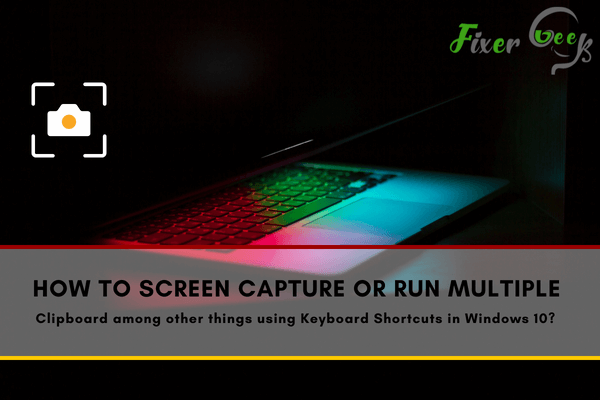How To Screen Capture Or Run Multiple Clipboard Among Other Things Using Keyboard Shortcuts In Windows 10?
Today, we are going to see all the kinds of shortcuts that can be installed on your computer using either keyboard combination or mouse gesture. You will also see, how to run multiple things at once in Windows 10!

Windows 10 is the company's latest in its series of operating systems, bringing with it a new set of features and capabilities for its users to discover. And one of the most important and most helpful of these is the keyboard shortcuts.
There may be some that you are already familiar with such as the usual copy and paste keys—don't worry, they're still Ctrl+C then Ctrl+V in Windows 10. However, there are still several shortcuts for you to learn to fully maximize the new OS.
Check out this guide on the top essential keyboard shortcuts in Windows 10!
- Before anything, you need to first identify what you want to do. For example, identify if you want to copy a part of the text or paste what you copied on a blank document.
- Once you have done so, locate the keyboard shortcut needed for that action. Listed below are some of the keyboard shortcuts available in Windows 10. These lists include both the essential and new keyboard shortcuts.
New Additions
The Windows key has always been known to simply open the start menu and minimize any open windows. Over time, it's grown to expand its use to more functions.
The Windows 2000 introduced the ability to lock the desktop while using the Windows Key in Windows XP would open the "Search for Computers." There are many more added in the iterations of Vista and Windows 8 and 8.1.
Keyboard shortcut for screen capture
Listed below are the new keyboard shortcuts that you can use with Windows 10:
Keyboard shortcut Action
Windows Key + C Opens voice input into Cortana.
Windows Key + S Opens Search.
Windows Key + I Opens Settings.
Windows Key + A Opens the Action Center.
Windows Key + X Opens the Quick Link menu.
Windows Key + Left arrow Snaps the current window to the left.
Windows Key + Right arrow Snaps the current window to the right.
Windows Key + Up arrow Maximizes the active window.
Windows Key + Down arrow Minimizes or removes the active window.
Windows Key + Ctrl + D Creates a new virtual desktop.
Windows Key + Ctrl + Left arrow Cycles virtual desktops to the left.
Windows Key + Ctrl + Right arrow Cycles virtual desktops to the right.
Windows Key + Ctrl + F4 Closes the current desktop.
Windows Key + Tab Accesses all desktops and apps in Task View.
Windows Key + PrtSc Takes a screenshot and saves it to the Screenshots folder.
Windows Key + G Opens the Game bar.
Windows Key + Alt + G Records the last 30 seconds.
Windows Key + Alt + R Manually starts and stops recording.
The Essentials
Now that you have an idea of the new shortcuts, here's a quick review of the essentials that you can still use in Windows 10:
Keyboard shortcut Action
Ctrl + A Selects all content.
Ctrl + C (or Ctrl + Insert) Copies selected items to the clipboard.
Ctrl + X Cuts the selected items to the clipboard.
Ctrl + V (or Shift + Insert) Pastes content from the clipboard.
Ctrl + Z Undos an action, including undelete files (though limited in capability).
Ctrl + Y Redos an action.
Ctrl + Shift + N Creates a new folder on your desktop or File Explorer.
Alt + F4 Closes the active window. (If there is no active window, the shutdown option appears.)
Ctrl + D (Del) Deletes the selected item to the Recycle Bin.
Shift + Delete Permanently deletes the selected item, foregoing the Recycle Bin.
F2 Renames the selected item.
ESC Closes the current task.
Alt + Tab Switches between the open apps.
PrtScn Takes a screenshot, which is stored in the Clipboard.
Windows Key + E Opens the File Explorer.
Windows Key + D Displays and hides the desktop.
Windows Key + V Opens the Clipboard bin.
Windows Key + L Locks the device.
Windows key + Period (.) or semicolon (;) Opens the emoji panel.
Windows key + Shift + S Captures a part of the screen using the program Snip & Sketch.
The Clipboard
The ability to copy and paste items relies on the Clipboard, which stores the image or text that you want to move around, though it's limited only to the last thing you copied. Another new feature of Windows 10 allows you to run multiple clipboards, meaning you can save multiple objects on it.

You need to head over to Settings, then to Clipboard, and toggle the Clipboard History on. After doing so, you just need to press Windows Key+V to open the Clipboard bin and choose which item you want to use.
Summary: Screen Capture or run Multiple Clipboard among other things using Keyboard Shortcuts in Windows 10
- Windows + D: The Desktop shortcut
- Windows + Ctrl + D : Create a new virtual desktop
- Windows + Ctrl + F4 : Close current virtual desktop
- Windows+Ctrl+Left/Right arrow keys: Switch between virtual desktops
- Windows + Tab : Open Task View
- Windows + Shift + S : Screen Capture and Draw on it
- Windows + M : Minimize All the windows on screen. This is one of my favorite Keyboard Shortcut.
- Windows + Left or Right Arrow Key : Snaps the selected window to the left or right of your screen, respectively, taking up a half of the display.
Conclusions
No one expects you to completely memorize every keyboard shortcut. The system is still fairly user-friendly even when you forget them. You only need to memorize the ones you use the most often to enjoy the benefits of these shortcuts.